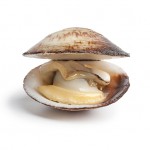Ed Yong describes a fascinating case of an infectious cancer in clams, which is weirdly cool (if not so good for the clams). To the rogues’ gallery of Canine Transmissible Venereal Tumors and Devil Facial Tumor Disease, we can now add this newly discovered immortalized clam blood cell that is spreading through populations.
He does not, however, answer the other important question: how do cancer-infected clams taste, compared to the other kind?



Clams have blood?
and legs
Um, HELA cells couldn’t evolve to do this, right?
Fascinating, if a tad grim. And sooner or later the armageddon preachers are going to get wind of this, and it’ll be proclaimed a sign of the apocalypse. “All the clams have cancer now! The end is near, just like it said in the Bible! [Insert twisted Bible quote here]”
Must be all that unprotected clam sex…
So I guess the big question is how these transmitted cancer cells in all these cases avoid the host immune system. It seems to me that figuring that out would go a long way toward developing approaches to prevent transplant rejection, as well as other possible important therapies for immune system dysregulation.
By coincidence — or mind-control beams from the ISS — I just finished a mussels, clams, potatoes, and onions masala soup for dinner. Worked quite well with the local French rouge I’m still enjoying.
I have no idea if there was also some organic shellfish leukaemia spice (but if there was, I would recommend i–burph!–t!)…
You have a cancer acting like pathogenic bacteria. O_O
Unlike other cancers, this seems to be in a position to evolve independently from a host.
And clams are in a position to evolve resistance.
Will it slowly become a species on its own?
There is already a facial tumor cancer known from Tasmanian Devils that acts and is spread like a disease. http://discovermagazine.com/2014/may/13-the-immortal-devil (Sorry for the Discovery Magazine link)
He mention Devil facial tumor.
Um, HELA cells couldn’t evolve to do this, right?
Yes, but they probably haven’t yet.
@6: Tasmanian devils don’t have a lot of genetic variability so the tumor had it easy: evade one immune system, evade them all. Dog transmissible tumor is usually not fatal in young dogs with healthy immune systems, only in those with weakened immune systems (IIRC.)
People will already refuse to eat, say, a beef tumour (I would sell it canned and labelled as “Le Petit Tumour” to fancy restaurants). How willing will they be when they learn that this tumour is transmissible between clams?
cervantes (@1)
Not only do clams have blood, but even more mind-blowing is that cockles have hearts.
So when they feel gratified, it warms the heart of cockles?
Does this also mean that the cockles of my heart have cockles? Because that doesn’t sound healthy.
Don’t forget Syrian hamsters! Although that one might only be transmitted by sharing needles, which hamsters rarely do in the wild.